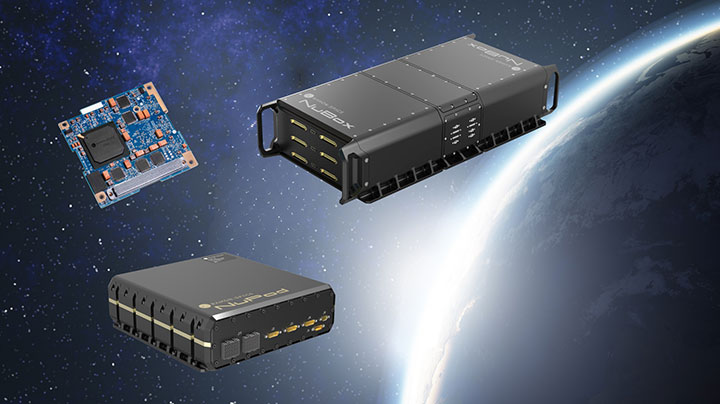ALEXANDRIA, Va. — Every so often an application comes along that shifts markets, displaces legacy technologies and even changes the way people live their lives. With mega-constellations of broadband satellites, a flood of sensor data from space and the prospects of an interconnected network from the surface of Earth to the moon, some are looking to space for the next software revolution.
 Advanced computing infrastructure is a key element in establishing an intelligent space network from Earth to cislunar orbit. (Source: Shutterstock)
Advanced computing infrastructure is a key element in establishing an intelligent space network from Earth to cislunar orbit. (Source: Shutterstock)
But before the space world produces the “next killer app,” there’s the not-so-insignificant matter of the underlying computing infrastructure to support it.
Ramon.Space got its start in precision, space-hardened semiconductors and processors. By 2019, the Israeli firm began developing advanced computing systems that would cover the three fundamentals of handling data: storage, processing and connectivity.
“What we need to do, essentially, is to enable the infrastructure in space to look like it is on Earth,” said Avi Shabtai CEO of Ramon.Space. “Once you have the infrastructure, you can accelerate the development of applications and services.”
Just as cloud computing infrastructure on Earth laid the foundation for countless new companies and services, a similar capability in orbit could prime the space industry for significant expansion.
A Mesh Network from Earth to the Moon
Ramon.Space’s main objective is to enable “Earth-like computing” in space, Shabtai explained, which requires a combination of space-hardened hardware—processors, storage, memory—and software-defined systems to adapt to various, evolving mission needs.
When computing capacity is less of a limitation, individual satellites can engage in more intensive processes, like running AI/ML algorithms, adapting a payload mission, even crypto mining. Having a baseline computing infrastructure across a satellite network mean each junction is intelligent and capable of data processing, storage and connectivity.
Ramon.Space’s computing platforms can be deployed in different configurations, from edge processing on a single satellite to data relay between a constellation. The computing systems can also serve a data center function serving a data center function—centralized or distributed—helping meet the growing demand for intelligently interconnected satellite networks.
“It’s not just what we do on a single satellite, it’s how you build networks in space that are similar, for example, to terrestrial infrastructure,” Shabtai explained. Terrestrial networks are increasingly a mesh of billions of access points facilitating a consistent, dynamic flow of information between nodes, utilizing any number of possible pathways.
“What happens in space is really the build-out of that mesh infrastructure that can enable every point to connect to every point,” he continued. Whether it’s an edge device on Earth, a satellite in orbit or a lunar communication outpost, each point becomes part of a content and data deliver network. “Once this is enabled, I think it will really change the space industry.”
 Ramon.Space computing products enable end-to-end data handling in space with massive processing power and high-density storage. (Source: Ramon.Space)
Ramon.Space computing products enable end-to-end data handling in space with massive processing power and high-density storage. (Source: Ramon.Space)
Since its founding, Ramon.Space technology has been deployed in various satellite and space missions. Its space computing systems were selected as part of an Israel Space Agency mission and will be part of an advanced navigation solution for the private Beresheet 2 lunar mission in 2025. The company was also recently selected as one of seven finalists in the OneWeb Innovation Challenge and will begin a co-engineering phase with OneWeb to advance global, high-speed connectivity.
Taking Advantage of Terrestrial Standards
Of the many challenges in bringing terrestrial computing to space, designing new standards is not one of them. Rather than designing purpose-built systems for isolated use cases, Ramon.Space is looking to leverage standardized software and hardware components to achieve scale and provide a familiar baseline for developers.
“You want to give engineers the ability to work in space as if they were working on Earth. You want to enable them to run Linux machines and containers and be able to port one application from a terrestrial network to space almost seamlessly,” Shabtai explained. “That’s how you accelerate the industry. That’s also how you use the right economic factors to drive this expansion.”
Using Linux-based computing platforms, containers and standard machine learning API functions, the user experience in space looks like working with a standard server on Earth. Today, the company boasts low-SWaP storage units with anywhere from 1-10 TB of storage and computational power comparable to advanced processors on Earth.
That leaves the biggest technology challenge: the space environment itself. Extreme temperatures, space weather events and radiation make one of the most hostile environments for electronics, particular on the scale of advanced computing systems.
“Unlike most of Earth equipment or technology that’s been deployed, you cannot really access the systems that are deployed in space. You cannot go and replace anything,” said Shabtai, noting the company’s technology has been used in 50 space missions and onboard several hundred satellites. “We are a company that’s investing in deep technologies. We are set to deal with challenges.”
Explore More:
How Edge Computing Is Changing Space from Terminal to Satellite
Podcast: NFV, SDN and Enabling Dynamic Satellite Ground Networks
DoD’s Increasing Demand for Data Fusion in Space
